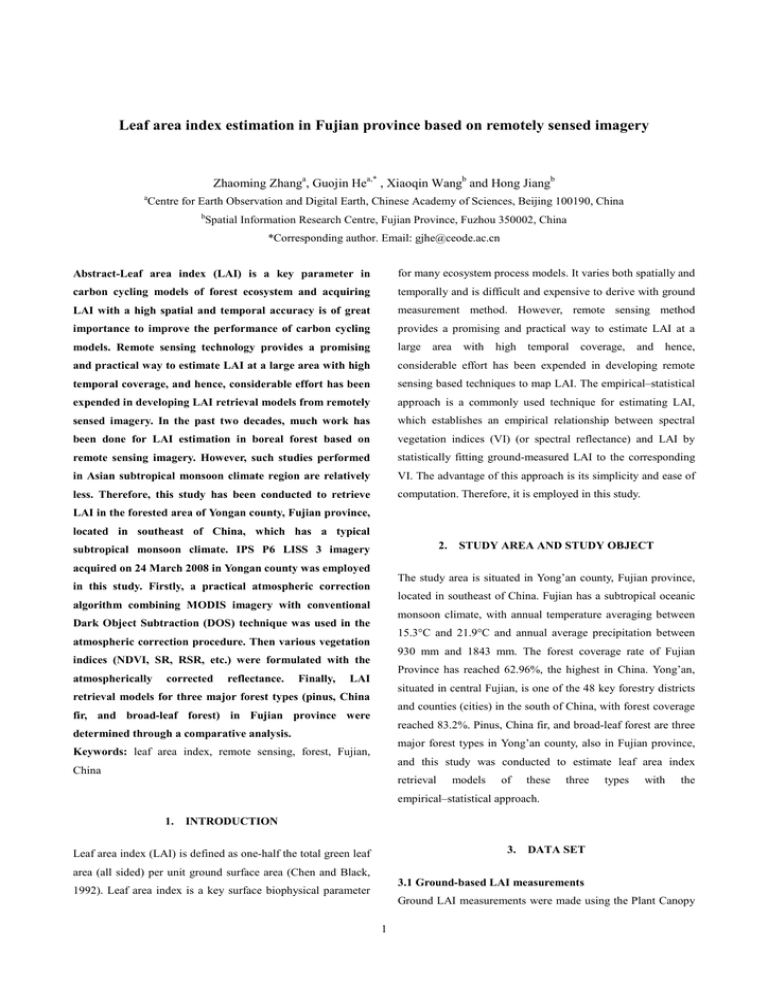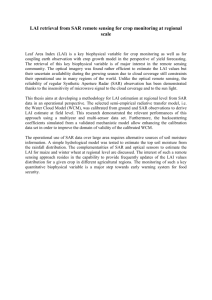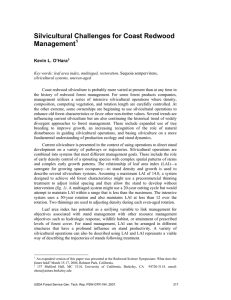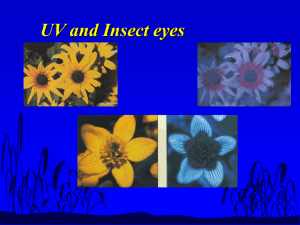Leaf area index estimation in Fujian province based on remotely... Zhaoming Zhang , Guojin He
advertisement

Leaf area index estimation in Fujian province based on remotely sensed imagery Zhaoming Zhanga, Guojin Hea,* , Xiaoqin Wangb and Hong Jiangb a Centre for Earth Observation and Digital Earth, Chinese Academy of Sciences, Beijing 100190, China b Spatial Information Research Centre, Fujian Province, Fuzhou 350002, China *Corresponding author. Email: gjhe@ceode.ac.cn Abstract-Leaf area index (LAI) is a key parameter in for many ecosystem process models. It varies both spatially and carbon cycling models of forest ecosystem and acquiring temporally and is difficult and expensive to derive with ground LAI with a high spatial and temporal accuracy is of great measurement method. However, remote sensing method importance to improve the performance of carbon cycling provides a promising and practical way to estimate LAI at a models. Remote sensing technology provides a promising large area and practical way to estimate LAI at a large area with high considerable effort has been expended in developing remote temporal coverage, and hence, considerable effort has been sensing based techniques to map LAI. The empirical–statistical expended in developing LAI retrieval models from remotely approach is a commonly used technique for estimating LAI, sensed imagery. In the past two decades, much work has which establishes an empirical relationship between spectral been done for LAI estimation in boreal forest based on vegetation indices (VI) (or spectral reflectance) and LAI by remote sensing imagery. However, such studies performed statistically fitting ground-measured LAI to the corresponding in Asian subtropical monsoon climate region are relatively VI. The advantage of this approach is its simplicity and ease of less. Therefore, this study has been conducted to retrieve computation. Therefore, it is employed in this study. with high temporal coverage, and hence, LAI in the forested area of Yongan county, Fujian province, located in southeast of China, which has a typical 2. subtropical monsoon climate. IPS P6 LISS 3 imagery acquired on 24 March 2008 in Yongan county was employed The study area is situated in Yong’an county, Fujian province, in this study. Firstly, a practical atmospheric correction located in southeast of China. Fujian has a subtropical oceanic algorithm combining MODIS imagery with conventional monsoon climate, with annual temperature averaging between Dark Object Subtraction (DOS) technique was used in the 15.3°C and 21.9°C and annual average precipitation between atmospheric correction procedure. Then various vegetation 930 mm and 1843 mm. The forest coverage rate of Fujian indices (NDVI, SR, RSR, etc.) were formulated with the atmospherically corrected reflectance. Finally, STUDY AREA AND STUDY OBJECT Province has reached 62.96%, the highest in China. Yong’an, LAI situated in central Fujian, is one of the 48 key forestry districts retrieval models for three major forest types (pinus, China and counties (cities) in the south of China, with forest coverage fir, and broad-leaf forest) in Fujian province were reached 83.2%. Pinus, China fir, and broad-leaf forest are three determined through a comparative analysis. major forest types in Yong’an county, also in Fujian province, Keywords: leaf area index, remote sensing, forest, Fujian, and this study was conducted to estimate leaf area index China retrieval models of these three types with the empirical–statistical approach. 1. INTRODUCTION 3. Leaf area index (LAI) is defined as one-half the total green leaf DATA SET area (all sided) per unit ground surface area (Chen and Black, 3.1 Ground-based LAI measurements 1992). Leaf area index is a key surface biophysical parameter Ground LAI measurements were made using the Plant Canopy 1 Analyzer (PCA), LAI-2000 (Welles and Norman 1991) Index, MNDVI; Reduced Simple Ratio, RSR, Formulae for (LI-COR Inc., Lincoln, NE, USA). The LAI-2000 measures the these VI are listed below) commonly used in forestry gap fraction in five zenith angles, ranging from 0° to 75°. The applications, were investigated. measured gap fraction data are inverted to obtain the effective NDVI = LAI under the assumption of a random spatial distribution of ρ n − ρr ρn + ρr ( Rouse et al., 1974) leaves. The ground measurements were performed in July 2008. Totally, 24 sample plots were selected for pinus, 19 for China SR = fir, and 23 for broad-leaf forest, respectively. All plots were geo-located using global positioning system (GPS) ρn ρr (Jordan, 1969) MNDVI = measurements with an accuracy of <20m in both the x and y directions. In order to prevent the effects of direct sunlight on RSR = the sensor, the instrument was only operated near dusk or dawn ρn − ρr ρ − ρ s min (1 − s ) (Nemani et al., 1993) ρn + ρr ρ s max − ρ s min ρn ρ − ρ s min (1 − s ) ρr ρ s max − ρ s min (Brown et al., 2000) or under overcast conditions. ρr, ρn, and ρs are red, near-infrared, and short wave infrared 3.2 Remotely sensed data preprocessing and reflectance (SWIR) reflectance, respectively. ρsmin is the SWIR reflectance estimation obtained from a completely closed canopy and ρsmax is the A cloud free IRS P6 LISS 3 image, acquired on March 24th, SWIR reflectance from an open canopy. 2008, was used in this study. The LISS 3 sensor observes with red For each forest type, relationships derived from the regression (0.62-0.68µm), near infrared (0.77-0.86µm) and short wave of ground based LAI measurements against these eight infrared (1.55-1.70µm) bands. Digital numbers stored in the modeling parameters (four single spectral reflectance and four LISS 3 image were converted to land surface reflectance before VI) were compared, and the best fitted empirical statistical any subsequent analysis was conducted. Firstly, the digital model was chosen (details as shown below). 24m pixel resolution at green (0.52-0.59µm), numbers of the scene were transformed into spectral radiance by using the gains and offsets obtained from the image header 4. 5 file. The atmospheric correction to convert the radiance values 4 into land surface reflectance was accomplished with the 3. 5 practical DOS model based atmospheric correction approach 3 I 2. 5 A L proposed by Zhang et al. (2010). 2 It should be noted that there is a discrepancy between image acquisition time and LAI collection time, because the bad imagery received when synchronous y = 0. 4139e 2 R = 0. 7821, p<0. 01 1 weather condition in southern China resulted in a cloudy optical 0. 4327x 1. 5 0. 5 0 ground 0 measurement of LAI was performed. However, considering the 1 2 3 4 5 6 RSR time interval between image acquisition and LAI collection is Figure 1. not large and LAI variation can be considered small during this broad-leaf forest period, error caused by the discrepancy should be acceptable. 4. The best fitted empirical statistical model for RESULTS AND ANALYSIS In the empirical–statistical approach, empirical relationships between LAI and reflectance in the four single spectral bands, and four VI (Normalized Difference Vegetation Index, NDVI; Simple Ratio, SR; Modified Normalized Difference Vegetation 2 data than the single spectral reflectance, because the single 3 spectral reflectance contains much noise. However, by 2 y = 0. 1035x - 0. 4338x + 1. 112 2 R = 0. 7545, p<0. 01 2. 5 constructing VI, the noise is greatly reduced. 2 IA L1. 5 References BROWN, L., CHEN, J. M., LEBLANC, S. G. and CIHLAR, J., 1 “A shortwave infrared modification to the simple ratio for LAI 0. 5 retrieval in boreal forests: An image and model analysis”. 0 Remote Sensing of Environment, 71, p.p. 16–25,2000. 0 2 4 6 8 CHEN, J. M. and BLACK, T. A., “Defining leaf area index for SR non-flat leaves”. Plant, Cell and Environment, 15, p.p. Figure 2. The best fitted empirical statistical model for pinus 421–429,1992. JORDAN, C. F., “Derivation of leaf area index from quality of 4 light on the forest floor”. Ecology, 50, p.p. 663−666,1969. 3. 5 NEMANI, R. R., PIERCE, L. L., RUNNING, S.W. and BAND, 3 2. 5 IA L 2 L., “Forest ecosystem processes at the watershed scale: y = 16. 272x - 8. 9735 2 R = 0. 6264, p<0. 01 sensitivity to remotely-sensed leaf area index estimates”. International 1. 5 of Remote Sensing, 14, p.p. 2519-2534,1993. 1 ROUSE, J. W., HAAS, R. H., DEERING, D.W., SCHELL, J. A. 0. 5 0 0. 4 Journal 0. 5 0. 6 0. 7 and HARLAN, J. C., “Monitoring vegetation systems in the 0. 8 Great Plains with ERTS”. Proceedings, 3rd Earth Resource NDVI Technology Satellite (ERTS) Symposium (p.p. 48−62) , 1974. Figure 3. The best fitted empirical statistical model for China WELLES, J. M. and Norman, J. M., “Instrument for indirect measurement of canopy architecture”. Agronomy Journal, 83, fir p.p. 818– 825, 1991. As shown in the above figures, the best modeling parameters ZHANG, Z., HE, G. and WANG, X., “A practical DOS model are RSR, SR and NDVI for broad-leaf forest, pinus and China based atmospheric correction algorithm”. International Journal fir, respectively. VI is better correlated to the measured LAI of Remote Sensing, 31, p.p.2837-2852, 2010. 3



